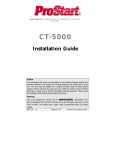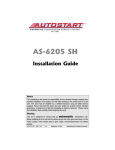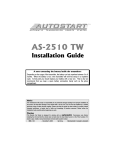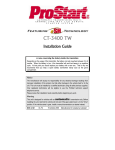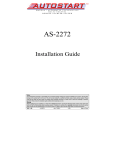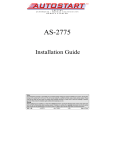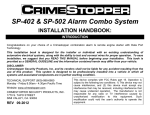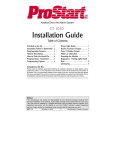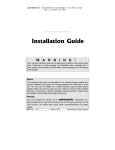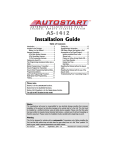Download Autostart AS-1535 SH Installation guide
Transcript
AUTOMATIC TRANSMISSION REMOTE STARTER SYSTEM AS-1535 SH Installation Guide Notice The manufacturer will accept no responsibility for any electrical damage resulting from improper installation of the product, be that either damage to the vehicle itself or to the Unit. This Unit must be installed by a certified technician using all safety devices supplied. Please note that this guide has been written for properly trained Autostart technicians, a certain level of skill and knowledge is therefore assumed. Please review the Installation Guide carefully before beginning any work. Warning This unit is designed for vehicles with an automatic Transmission only. Before installing the Unit, test that the vehicle will not start if the gear select lever is in the “Drive” position. If the vehicle starts in gear, install a manual-transmission Car Starter instead. H.2.40 S.3.00 Rev. XWWDS CA – June 23, 2003 Manufactured in Canada by Autostart Table of Contents Introduction ..................................................... 3 Included in the Package ................................. 3 Before You Get Started…............................... 3 Harness Description ....................................... 4 6-Pin Main Ignition Harness ....................... 5 5-Pin Secondary Harness........................... 5 12-Pin Accessories Harness ...................... 6 2-Pin Harness ............................................. 9 Flashing the Hood Pin .................................... 9 What is Flashing the Hood Pin? ................ 9 The Programming Assistance Button (A.k.a. PAB.) ............................................................ 10 How to Program the Transmitter. ................. 10 How to Enter Options Programming Mode... 11 Options Programming................................... 12 Horn Honk Timing (Optional).................... 13 Auto Tach Programming Procedure........ 14 Multi-Speed Tach Programming................... 14 P.2 Testing.......................................................... 14 Closing Up.................................................... 15 Supplementary Information .......................... 15 Fifth Relay Output (2nd IGN or 2nd ACC or 2nd START)............................................... 15 Ignition-Controlled Door Locks ................. 16 Secure Lock.............................................. 16 Turbo Mode .............................................. 17 Safe Start (Child Safety Mode)................. 17 Vehicle Type – Gas Or Diesel .................. 17 Passive Or Active Arming......................... 17 Resetting The Module .................................. 17 Events Logging............................................. 17 Events playback ....................................... 17 Start Failure Codes via Parking Lights..... 18 Diagnostics - Parking Lights Flash Rate ...... 19 Installation Guide AS-1535 SH Introduction This Guidebook contains all information pertinent to the installation. Most (if not all) features are grouped in the User Guidebook and therefore, should you need information on a feature, you should refer to the User Guidebook Included in the Package Before beginning the installation, please review the Installation Guide – especially the Wiring Diagram and the Options Programming. It is very important that you familiarize yourself with the programming and operation of the system, even if you have already installed an Autostart system in the past. There are many great new features that may be overlooked if you do not read the manual; this would prevent you from maximizing the potential of the Module. Prior to the installation, make sure that all the hardware components required to install the system are in the box. The following is a list of components included in the kit: x 1 – Control Unit x 1 – Long-range super-heterodyne Receiver x 1 – Plug-in push-button Valet switch (the Valet Button) x 2 – Five-button multi-channel Transmitter x 1 – Antenna interconnect cable x 1 – Plug-in 2-volt LED x 1 – 6-pin main Ignition Harness x 1 – 5-pin Secondary Harness x 1 – 2-pin Secondary Harness x 1 – 12-pin Accessories Harness x 1 – Hood Pin-switch x 1 – Warning label x User Guide Installation Guide INDUSTRY CANADA USER NOTICE (Canada): Operation is subject to the following two conditions: (1) this device may not cause interference, and (2) this device must accept any interference, including interference that may cause undesired operation of the device. To reduce potential radio interference to other users, the antenna type and its gain should be so chosen that the equivalent isotropically radiated power (EIRP) is not more than that required for successful communication". FCC USER NOTICE (U.S.A.): The manufacturer is not responsible for any radio or TV interference caused by unauthorized modifications to this equipment. Such modifications could void the user’s authority to operate the equipment. Before You Get Started… Ƈ On vehicles with a manual Transmission, always ensure that all Doors will get the Unit out of Ready Mode. Switch the wire used so that it is triggered by all Doors. AS-1535 SH Installation Guide Ƈ Make sure that the Parking Brake and Door Switch contacts work properly. Ƈ When working on a vehicle, always leave a window open. P.3 Ƈ Never leave the keys in the car. Leave them on a workbench with a window rolled down. Ƈ Remove courtesy light fuse, if possible, to prevent battery drain. Ƈ The Programming Assistance Button (A.k.a. PAB.) The PAB is mounted on the side of the Unit. This push button mimics the Hood-Pin switch in order to avoid having to get out of the vehicle and pressing the Hood-Pin switch. The PAB will work only when the Hood is up. Ƈ Inspect vehicle for any body damage or electrical problems Ƈ Always solder and tape all connections. Ƈ Keep the Transceiver away from other types of antennas (GPS/Onstar). Ƈ Never install the control unit where it could interfere with normal operation or obstruct service technicians. Ƈ Always use a grommet when running wires into the Engine compartment. Never run wires through bare or sharp metal. Ƈ Do not disconnect the battery on vehicles equipped with air bags and anti-theft radios. Ƈ Never ground the control unit to the vehicle’s steering column. Ƈ Make sure that all the switches and controls operate properly. Ƈ Verify that the vehicle starts and idles properly. Ƈ Make sure that all safety equipment is installed: the Valet Button, the Hood Switch and the warning label Ƈ When wiring in parallel, make sure to isolate each connection with a diode in order to avoid feedback and possible damage. Examples: Wiring a clutch bypass and a Transponder Module to the Ground Out when Running wire: At the junction point, where Ground Out when running “splits” and goes to each device, a diode is inserted on each of those lines. Multiple or Separate Door pin Connections: When joining all door pins together to the Door pin input wire of the Module, each wire must be isolated with a diode to prevent feedback. N.B.: The above examples reflect common situations where diodes are used to isolate. Please note that there are numerous other scenarios where diode isolation are required. Ƈ Always make sure that any external relays or modules added to the Remote Starter Module are properly fused, and diode isolated. Ƈ When testing the Shock Sensor, never test on glass with an opened hand, and never hit glass hard enough as to break it. When testing on Metal or plastic, make sure the testing does not result in damage to the vehicle (i.e.: dents, broken glass, damaged trims, etc.). Ƈ Vehicles equipped with daytime running lights may not allow the installer to view certain programming results since the daytime running lights do no go out (Note: The Parking Light output relay in the Module gives two “clicks” per flash, 1 click for ON and 1 click for OFF). Ƈ Parking Light flashes referred to in this manual refer to the Parking Light output of the Module and not that of the vehicle. Harness Description When connecting an Autostart Module, it is important to make sure the connector with the Ground wire is connected first before making the 12-volt connections. Should the unit be powered before being grounded, there could be serious damage to internal components of the unit. Be careful not to power up a Module before it is properly grounded. To avoid any accident, it is a recommended to pull out the fuses from their sockets before the installation, and to put them back during the very last steps. P.4 Installation Guide AS-1535 SH 6-Pin Main Ignition Harness Wire Description Connect to the largest 12 V supply wire at the Ignition harness. Ensure that the OEM power wire is fused for more than 30 A. NOTE: certain new vehicles have no suitable 12 volts source at the RED A +12 V Battery IGNITION switch (the 12 Volt wire is too small to supply the necessary current). In this case, the fuse box, or the B+ connection on the battery is recommended. B PURPLE Connect to the Starter wire of the vehicle (at the IGNITION switch). The source (+) 30 A starter output wire should have +12 V with the Ignition Key in the Crank position only. Connect to the largest 12 V supply wire at the Ignition harness. Ensure that the OEM power wire is fused for more than 30 A. RED NOTE: certain new vehicles have no suitable 12 volts source at the C (+) 12 V IGNITION switch (the 12 Volt wire is too small to supply the necessary Battery current). In this case, the fuse box, or the B+ connection on the battery is recommended. Connect to Ignition wire of the vehicle. The source wire should have +12 V with the Ignition Key in the Ignition On (Run) and Crank positions. YELLOW Warning: some vehicles have more than one IGN wire at the IGNITION (+) 30 A D switch for powering the heater blower motor. Use the 5th relay (pin F) and ignition extra relays to power up any extra IGN. wires if necessary. DO NOT JUMP output WIRES at the IGNITION switch, this will compromise the OEM electrical system. This wire is for powering the heater blower motor. It is usually classed as an Acc. (no power in the crank position.) if it tests as an IGNITION (power in the crank pos.) then power it as an IGNITION (5th relay, or extra fuse). ORANGE Warning: some vehicles have more than one ACC wire at the IGNITION (+) 30 A E Accessories switch for powering the heater blower motor. Use the 5th relay (pin F) and output extra relays to power up any extra ACC. wires if necessary. DO NOT JUMP WIRES at the IGNITION switch, this will compromise the OEM electrical system. This high-current output can be used to power a 2nd IGNITION or a 2nd ACCESSORY or a 2ND STARTER WIRE. See jumper settings on page 16 for GREEN correct output. th F (+) 30 A 5 relay output Additional IGNITIONS, ACCESSORIES, or STARTER WIRES must use external relays. DO NOT JUMP WIRES at the IGNITION switch, this will compromise the OEM electrical system. 5-Pin Secondary Harness Wire Description 1 BLACK (–) Chassis ground input 2 PURPLE (AC) Tachometer input This wire must be connected to bare, unpainted metal (the Chassis or true Body ground). It is preferable to use a factory ground bolt rather than a selftapping screw. Screws tend to get loose or rusted over time and can cause erratic problems. This wire tells the Module if the Engine is running or not. It requires at least 1.8 volts (AC) and 1.5 Hz (or faster) at idle. Common Tach references are: the negative side of an injector, the negative side of an Ignition Coil, Camshaft sensor, Crankshaft sensor or the Engine Control Module (ECM). AS-1535 SH Installation Guide P.5 NOTE: A Tach signal that is too low will cause the Module to “over crank” and a Tach signal that is too high will cause the Module to “under crank”. 3 GREY (-) Hood Switch input Connect this wire to the Hood Pin-switch supplied. This input will disable or shut down the Remote Starter when the Hood is opened. It is also used for programming and therefore it is essential that it is installed. 4 ORANGE (+) Brake Switch input 5 YELLOW +12 V Parking Light output This wire must be connected to the Brake Light switch of the vehicle. The wire should be +12 V only while the Brake Pedal is pressed. This input will shut down the Remote Starter if the Brake Pedal is pressed. It is also used for programming and therefore it is essential that it is installed. This wire provides a +12 V output (15 A max.) and must be connected to the Parking Light wire that tests +12 V when the Parking lights are ON. Note: Ensure that the voltage does not vary when the dimmer control switch is turned up or down. If this is the case, it is not the right wire. There is a also a negative Parking Light output. Only one of these two different outputs needs to be connected. 12-Pin Accessories Harness Wire Description 500 mA negative output. This output can be used to control Trunk release (1-sec. pulse) or can be set to operate as a constant output as long as the TRUNK button is held pressed. (For Sunroof or Window close). Note: AUX3 (TRUNK) operates only when Ignition is OFF or when the vehicle is running under remote control. 1 BLUE (–) AUX 3 (Trunk) output 2 BROWN (–) Lock output 3 GREEN (–) Unlock output Programmable 500 mA, 1/10-sec., 7/10-sec., 4-sec. or a double ¼-sec. pulse negative output. 4 WHITE / BROWN (–) Arm output 500 mA ground output when the LOCK button is pressed. This output is activated 500 ms before the LOCK pulse and deactivated 250 ms after the LOCK pulse ends. Note: The system will also give an ARM/REARM pulse on this wire when it shuts down the vehicle after a remote start. 5 6 P.6 WHITE / GREEN (–) Disarm output BLUE / WHITE (-) Negative AUX1 Output Programmable 500 mA, 1/10-sec., 7/10-sec. or 4-sec. negative output. 500 mA ground output when the UNLOCK button is pressed. This wire is for disarming OEM Alarm systems. Note: System will also give a DISARM pulse before remote start. 500 mA ground output on the 2nd consecutive press of the UNLOCK button for Priority Door Access, or a Horn Confirmation on the first or second press of the LOCK button –depending on the option that was selected in the Programming Menu (see page 13). Installation Guide AS-1535 SH 7 WHITE / ORANGE (–) Starter Kill output 8 ORANGE (–) AUX 2 Output 9 PURPLE (-) External Trigger The unit is equipped with a selectable passive- or active-arming Starter Kill circuit that will immobilize the vehicle when the system is armed. This wire will provide a constant 500-mA negative output when the system is armed (locked by remote) or if remote started. This wire should be connected to a Single Pole Double-Throw Relay (This wire will connect to Pin 85, on the Relay, and Pin 86 will be connected to the Ignition wire). A second benefit of the Starter Kill is the Anti-Grind feature. When the vehicle has been remote started the Anti-Grind prevents the starter motor from re-engaging when the ignition key is inserted in the Ignition switch and accidentally turned to the CRANK position (The Starter Kill output becomes active during remote starts). Negative 500mA output. Can be programmed for one of the following three options: (1) Constant while the LOCK and UNLOCK buttons are pressed + 1 sec after release of the buttons. (2) LOCK + UNLOCK toggles ON / OFF. (Max.30 sec) (3) LOCK + UNLOCK toggles ON / OFF. (Max.60 sec) (4) Priority Door Access (2nd UNLOCK press) The External Trigger wire can be used for remote-starting the vehicle with an external device. When the vehicle is running, triggering this input will activate Idle Mode. The External Trigger wire can also be used to operate as a negative trigger with the Trunk Pin-switch, the Key Sense wire or the Door Pin-switch: Option 1 Connects to Negative Trunk Pin. When this wire is programmed for TRUNK PIN, pressing TRUNK will activate a 1-second DISARM output. If ground (-) is detected on the TRUNK PIN (the Trunk has been opened), an ARM pulse will be sent 5 seconds after the Trunk is closes. An ARM pulse will be sent 4 seconds after the TRUNK button is pressed if the Trunk pin state is unchanged (The Trunk was unopened). DISARM is sent only if the system was previously locked and armed. If Secure Lock is enabled, UNLOCK pulse(s) will be sent with DISARM, a LOCK pulse and a REARM pulse will be sent when the Trunk is closed or if the Trunk was left closed. Option 2 (Default: Engine Start/Stop): The first Ground (-) pulse on this input will start the Engine, the second Ground (-) pulse on this input will stop the Engine. AS-1535 SH Installation Guide P.7 9 (cont.) PURPLE (-) External Trigger Option 3 (Key Sense (-) Input): Connects to OEM Key Sense Wire. When the Key is detected in the Ignition Switch (Ground (-) signal on the OEM Key Sense Wire) the Starter Kill will not ARM even when it is set to Passive Mode. If Secure Lock is programmed, LOCK and ARM will not be activated while the Key Sense input is active (“active” meaning there is a key in the Ignition barrel). Option 4 (Smart Ignition Re-Lock): Connects to the Negative Door trigger Input. When the Ignition Lock Option or the Lock Only Option is enabled: after the Brake Pedal is pressed and after a Door has been opened and closed, the Doors will RE-LOCK. 10 WHITE (–) Ground out when running 11 GREY N/A 12 P.8 YELLOW (+) Glowplug Light input This is a 500-mA constant ground output active when the vehicle is running under a remote start. The output becomes active 1-second before the Ignition and becomes inactive when the Module shuts down (i.e.: runtime has expired or the STOP button is pressed, etc.). The output can be used to activate external relays, bypass kits, etc. CAUTION! If multiple relays or modules are connected to the Ground Out wire, ensure that they are all diode isolated in order to avoid feedback and damaging the vehicle. Leave this pin empty. This positive input will monitor the Glow Plug Light in Diesel Mode: it will wait until the Glow Plug Light goes out to crank the Engine. Connect to the side of the Glow Plug Light that is positive when the Light is on. Note: In Diesel Mode there is a 15-sec. crank timing delay (or 25-sec. if the run time is set to 30 min.): if the Glow Plug Light is still on after the delay expires, the Module will proceed to start the Engine. (Also known as the “wait-to-start light”.) The purpose of the Glow-plug circuit on diesel vehicles is to pre-heat the Combustion Chamber before the vehicle is started. When a Remote Starter is installed on a diesel vehicle, the Glow- plug section of the Ignition circuit must be activated and allowed to operate before the vehicle is remote-started. For that purpose, the Glow-plug input wire of the Module must be connected to the Glow-plug indicator light of the vehicle. The Module will only accept positive Glow-plug input signals, if the signal is negative, use a relay to invert its polarity. Installation Guide AS-1535 SH 12 (cont.) YELLOW (+) Glowplug Light input (cont.) A diode must be added between the negative Glow-plug trigger on the relay and the negative Glow-plug wire of the car. This is to prevent feedback effects on the Glow-plug indicator light on the instrument cluster: the light on the dash would come on because of the feedback, even though the circuit is off. When the user remote-starts the vehicle: x The Module will power up the Ignition circuit and wait to engage the Starter Motor while the Glow-plug indicator light is still on. x The Module will engage the Starter Motor as soon as the Glow-plug light (+) goes out. x Minimum waiting time is 3 seconds. x Maximum waiting time is 18 seconds. If no Glow-plug wire is found on the vehicle, the Glow-plug input on the Module may be “timed out”. The Module will power up the Ignition and Glow-plug circuits and simply wait for the time-out before starting: x Connecting the Glow-plug input wire of the Module to Ignition will hold the ignition ON for the maximum waiting time (18 sec., recommended). x Keeping the Glow-plug input wire of the Module unconnected will hold the ignition ON for the minimum waiting time (3 sec., not recommended in very cold environments). Connect the Glow-plug wire to the Ignition wire only after Tach has been programmed (i.e.: Connecting the Glow-plug wire is one of the very last steps in the installation process). 2-Pin Harness Wire Description 1 BLUE / WHITE This pin is not used – leave it empty. N/A 2 YELLOW (-) Parking Light output x 500 mA negative Parking Light output Note: Ensure that the voltage does not vary when the dimmer control switch is turned up or down. If this is the case, it is not the right wire. There is a also a positive Parking Light output. Only one of these two different outputs needs to be connected. Flashing the Hood Pin What is Flashing the Hood Pin? It is a procedure that makes the Module go into the Programming Centre. Once the Module is in the Programming Centre, the Installer has no more than 20 seconds to get into one of the sub-menus. Failure to do so will result in the Module exiting the Programming Centre and the Installer will have to Flash the Hood Pin once more. Remember: You can use the Programming Assistance Button instead of the Hood Pin any time the Hood is up. AS-1535 SH Installation Guide P.9 The Installer … The Module … 123- Press and hold the Hood pin for 4 seconds. Let go of the Hood Pin. Parking Lights “ON” While the Parking Lights are on, press down the Hood Pin once more. 4- Release the Hood Pin again --be careful not to “ON” for 20 seconds over flash the Hood Pin as this will bring up the Events Playback and will not bring you the Programming Centre. 5- You have 20 secs to select one of the sub-menus. Once inside the Programming Centre, the Installer has a selection of many different submenus. Once you are in the Programming Centre, you have the option of the following menus: a) Transmitter Programming ………………….. p.10 b) Options Programming …………………..… p.11 c) Honk Horn Timing* (*if available) ………..… p.13 d) Tach Programming …………………..……… p.14 Remember: Once the Parking Lights are on Solid, you have up to 20 seconds to select a sub-menu. Failure to do so will result in the Module exiting the Programming Centre and you will have to Flash the Hood Pin once more. The Programming Assistance Button (A.k.a. PAB.) The PAB is located on the side of the Module. This push button mimics the Hood-Pin switch in order to avoid having to get out of the vehicle and pressing the Hood-Pin switch. The PAB will work only when the Hood is up. How to Program the Transmitter. 1. FLASH the Hood Pin Switch. Before the 20 seconds have passed, turn the Ignition Key to the IGNITION ON (RUN) position. Turn the IGNITION to OFF. 2. Press and hold the LOCK button until the vehicle gives 5 flashes. The Module has stored the Transmitter in its memory. 3. Close the Hood, to exit. Table 1 P.10 Installation Guide AS-1535 SH The Module has the ability to retain up to 4 different Transmitter codes; if a fifth Transmitter is programmed, the code of the first Transmitter will be erased from memory. To erase all Transmitter codes from memory, you must perform a Module reset (See “Resetting the Module” on page 17 ). To program the Transmitter on a second vehicle (Multi-car Operation), you must press the TRUNK and LOCK buttons (of the secondary Transmitter you wish to program) during step 2 of Transmitter Programming. How to Enter Options Programming Mode The System is equipped with three custom Programming Modes, allowing the installer to custom-fit the system according to the requirements of each vehicle. When getting into the Option Programming Mode, the Parking Lights and the Siren will flash and chirp once, twice or three times depending on the option you have entered. The unit will stay in Programming Mode until the Hood Pin-switch or the Brake Pedal is pressed again. Therefore take your time to make the proper selection. To return to the Programming Centre (Main Menu), press on the Brake Pedal. 1. FLASH the Hood Pin Switch. Before the 20 seconds have passed, 2. Press and hold the Brake Pedal, then press one of the following buttons on the Transmitter: x LOCK to enter Mode 1; x UNLOCK to enter Mode 2; or x TRUNK to enter Mode 3. The Parking Lights and the Siren will flash and chirp once, twice or 3 times to confirm entry into a Mode. 3. Release the Brake Pedal. Table 2 The Module can only be programmed Function by Function. After selecting a Mode (from 1 to 3), you will be taken to the first Function of that Mode. After entering an Option number for Function 1, you will be automatically taken to Function 2, and so on; therefore, be ready to re-enter all option numbers for all functions of the Mode you are accessing. You may not skip Functions. For each Function, select one of the four Options by pressing the corresponding button on the Transmitter: x LOCK for Option 1, x UNLOCK for Option 2, x TRUNK for Option 3, or x START for Option 4. Table 3 Once an Option has been selected the Parking Lights will flash 1, 2, 3 or 4 times depending on the selected Option. At any time, you can press the Brake Pedal to return to the Programming Centre (Programming Modes and Tach Programming). AS-1535 SH Installation Guide P.11 Options Programming MODE 1 *indicates default setting FUNCTION 1 – Ignition-controlled Door Locks OPTION 1* Ignition Locks ENABLED OPTION 2 Ignition Locks DISABLED OPTION 3 Ignition LOCK only OPTION 4 Ignition UNLOCK only FUNCTION 2 – Secure Lock OPTION 1* Secure Lock DISABLED (1-second Disarm pulse) OPTION 2 Smart Secure Lock ENABLED OPTION 3 Secure Lock DISABLED (1/2-second Disarm pulses) OPTION 4 Standard Secure Lock FUNCTION 3 – Passive / Active Starter Kill OPTION 1* Starter Kill PASSIVE (1-minute timeout) OPTION 2 Starter Kill ACTIVE OPTION 3 Starter Kill PASSIVE (3-minute timeout) FUNCTION 4 – Door Locks Timing OPTION 1* 7/10-sec. LOCK / UNLOCK pulses OPTION 2 4-sec. LOCK / UNLOCK pulses OPTION 3 a single 7/10-sec. LOCK pulse and two 1/4-sec. UNLOCK pulses OPTION 4 1/10-sec. LOCK and 1/10-sec. UNLOCK pulses MODE 2 *indicates default setting FUNCTION 1 – Safe Start Mode OPTION 1 Safe Start ENABLED OPTION 2* Safe Start DISABLED OPTION 3 Swap Start: Ɣ START signal = LOCK + UNLOCK buttons Ɣ AUX 2 signal = START button FUNCTION 2 – Engine Run Time OPTION 1 Run time = 4 minutes in Gas Mode / 9 minutes in Diesel Mode OPTION 2* Run time = 15 minutes in Gas Mode / 20 minutes in Diesel Mode OPTION 3 Run time = 25 minutes in Gas Mode / 30 minutes in Diesel Mode FUNCTION 3 – Idle/Turbo Mode OPTION 1 Idle/Turbo Mode DISABLED OPTION 2* Idle/Turbo Mode ENABLED OPTION 3 Idle/Turbo Mode DISABLED FUNCTION 4 – Gas or Diesel Mode OPTION 1 Diesel Engine (Cold Weather Mode run time = 20 min.) OPTION 2* Gasoline Engine OPTION 3 Diesel Engine (Cold Weather Mode run time = 9 min.) FUNCTION 5 – Ignition Valet OPTION 1 Enabled P.12 Installation Guide AS-1535 SH OPTION 2* OPTION 3 MODE 3 Disabled Disabled *indicates default setting FUNCTION 1 – Home Valet Mode OPTION 1 Home Valet ENABLED OPTION 2* Home Valet DISABLED OPTION 3 Home Valet DISABLED FUNCTION 2 – AUX 3 / Zone 3 output OPTION 1 Trunk output when TRUNK button pressed for 3-sec while Ignition is OFF OPTION 2* Constant while TRUNK button is pressed OPTION 3 Trunk output with Disarm / Rearm pulses. FUNCTION 3 – AUX 2 output OPTION 1 Constant while pressed (LOCK & UNLOCK pressed simultaneously, or START in Safe Start Mode.) OPTION 2* Toggle ON / OFF with timeout up to 30 seconds OPTION 3 Toggle ON / toggle OFF with timeout up to 60 seconds OPTION 4 Priority Door Access FUNCTION 4 – AUX 1 output OPTION 1 Horn Confirmation on second press of the LOCK button OPTION 2* Priority Door Access OPTION 3 Horn Confirmation on first press of the LOCK button FUNCTION 5 – External Trigger Sense OPTION 1 Zone 3 (Trunk pin) rearm (sends a Disarm pulse before Trunk opening and rearms 4 sec. after the Trunk is closed) OPTION 2* Engine START / STOP OPTION 3 Key Sense OPTION 4 Smart Ignition Lock Horn Honk Timing (Optional) 1. Make sure that Mode 3 Function 4 Option1 or Option 3 is activated. 2. FLASH the Hood Pin Switch Before the 20 seconds have passed, 3. Press and hold the Brake Pedal. x Press the START and UNLOCK buttons simultaneously on the Transmitter. x The Horn will Honk 5 times. 4. Release the Brake Pedal. 5. To change the timing: a. To increase the Horn Honk by 3 ms, press the LOCK button. b. To increase the Pulse by 10 ms, press the START c. To decrease the Pulse by 3 ms, press the UNLOCK button. d. To decrease the Pulse by 10 ms, press the TRUNK button. 6. To save the setting: press LOCK and UNLOCK. If 3 Honks are heard the new value has been saved. For each timing change, the Horn will Honk with the new settings, except under the following circumstances: x When the lower limit of 5 ms is reached, the Horn will sound for 1/4 second. x When the upper limit of 200 ms is reached, the Horn will sound for 3/4 second. A system reset will set the system back to the default: 30 ms AS-1535 SH Installation Guide P.13 Close the Hood to cancel the changes. Table 4 Auto Tach Programming Procedure This process can be carried out instead of the conventional Tach Programming Procedure. 1. Make sure all the connections are done properly and that the Module has been powered-up. 2. With the Hood up (Ground on the Hood Pin line), start the vehicle using the key. 3. Let the Engine reach proper idle speed The Parking Light output from the Module is activated when the vehicle starts and it will shut off once the Tach signal is detected. 4. Press and hold the Brake Pedal until the Parking Light output from the Module flashes 5 times. 5. Turn the Ignition OFF. At this point, the Tach setting has been programmed. Table 5 Multi-Speed Tach Programming No manual adjustments are necessary. However, you should go through the Tach programming procedure every time a new Unit is installed. 1. 2. 3. 4. FLASH the Hood Pin Switch. Press and hold the Brake Pedal. x Press the LOCK and UNLOCK buttons simultaneously on the Transmitter. x The Parking Lights will flash 4 times the Horn will Honk 4 times (if programmed). x Release the Brake Pedal. Start the vehicle and let it to reach regular Engine-idle speed. Once the vehicle is idling properly, press and hold the Brake Pedal until the Parking Lights flash five times, release the Brake Pedal: the Tach signal is now programmed. x The Horn will Honk 1, 2 or 3 times depending on the Tach mode which has been detected. Table 6 NOTE: If no tach has been programmed and the START button is pressed, there will be no start attempt and the vehicle will give 5 flashes. If another Tach Programming is required, simply repeat the Auto Tach Programming Procedures. The Module stores the Tach setting, being Auto Tach or conventional Tach, until the Module is reset. Testing Before putting back the vehicle together, it is recommended to check that the system operates properly. The following testing procedures should be used to verify proper installation and operation of the system. Before testing, make sure that all connections are soldered and that the unit is plugged in. 1. Remote-start the Engine and listen for Starter drag. If the Starter cranks for too long, carry out another Tach learning procedure. P.14 Installation Guide AS-1535 SH 2. 3. 4. 5. 6. 7. Test Hood Switch shutdown: with the vehicle running under the Remote Starter, open the Hood; the vehicle should shut down. If it does not shut down, check the Hood Pin-switch and its connector. Test the Brake shutdown circuit: With the vehicle running under the Remote Starter, press and release the Brake Pedal. The Engine should shut down immediately. If the Engine continues to run, check the Brake Switch connection. Door Locks, Auxiliary Outputs and Trunk Testing: Make sure each of these options respond to the Transmitter (if they were installed). Starter Kill option: Sit inside the vehicle with all the Doors closed. Arm the vehicle and then try to start the vehicle with the key –it should not start. If the vehicle starts, rewire the starter kill so it functions properly. Valet Mode: Make sure the Module is able to enter and exit Valet Mode properly. When setting the Module into Valet mode, the Starter Kill function is disabled, when pressing LOCK the Doors will lock but the Starter Kill will not be activated. (Refer to User Guide for more information on Valet Mode) Idle Mode: Make sure the vehicle properly goes into Idle Mode. Closing Up Use tie-wraps or screws to properly secure the Module and keep the wiring away from any moving parts such as the Parking Brakes or Steering Column Shafts. Mount all switches in good and accessible locations where they do not risk getting kicked or hit accidentally. Any under hood wiring should be split loomed and tie strapped away from moving parts and heat sources. Always make all your connections before plugging in the Module. Keep in mind to plug the fuses as the last step before the initial powering of the Module. Be sure to test all functions properly before closing up the installation. Make sure the Warning Label is applied on a visible place under the Hood. Most comebacks are the result of misunderstandings about how a product works or performs. Take the time to properly explain all functions and features to the customers before they leave the premises. Doing this will save time and money. Supplementary Information Fifth Relay Output (2nd IGN or 2nd ACC or 2nd START) This Remote Starter is equipped with a high-current programmable 5th relay onboard that can be used to power a second Ignition, Accessory, or Start wire. The Unit uses a series of jumpers; each set of jumper pins represents a function. In order to activate any one of the three possible 2nd outputs, you must place the jumper (supplied) on one of the three sets of pins and simply connect the 14 AWG wire to the second IGN or ACC or START wire of the vehicle. AS-1535 SH Installation Guide P.15 Caution! Do not use more than one of the three sets of jumper pins simultaneously. The relay output rating on this Unit is 25A max output. Defective OEM solenoid switches can sometimes draw up to 50 or 60A, causing the 30A fuse to blow. Using a digital voltmeter, check the Starter wire for amperage when vehicle is cranking. Ignition-Controlled Door Locks x x x x Ignition Lock enabled: locks all Doors when the key is in the ON position and the user presses the Brake Pedal. Similarly, when the Ignition key is turned to the OFF position, the Doors will unlock. Ignition Lock disabled: turns OFF the Ignition Lock feature. Ignition Lock Only: the system will only lock all Doors when the Ignition Key is turned to the IGNITION ON (RUN) position and Brake Pedal is pressed. Ignition Unlock Only: the system will unlock all Doors when the Key is turned to the OFF position, provided the Ignition Key was in the IGNITION ON (RUN) position and the Brake Pedal was pressed at least once. Table 7 Secure Lock (OFF by default.) For vehicles where the OEM Alarm can be controlled the through the OEM LOCK and UNLOCK wires, Secure Lock saves the installer from connecting the ARM and DISARM wires and the LOCK and UNLOCK wires to the OEM LOCK and UNLOCK wires. Upon receiving a remote start signal the system will unlock the Doors (disarming the OEM Alarm); 1/2 sec after the remote start, the system will LOCK the Doors. Please note: most factory Alarm systems will not rearm while the Engine is running but will lock the Doors. 4 seconds after the Module shuts off (i.e.: runtime expired or pressing the STOP button), Secure Lock will LOCK (once more) all the Doors of the vehicle and REARM the OEM Alarm. Smart Secure Lock operates as follows: x If the Alarm is armed and the Starter Kill is armed, a remote start signal will be accompanied by an UNLOCK and a DISARM pulse preceding start-up. The system will LOCK and arm again once the Engine is running. x If the Vehicle is initially unlocked, a remote start signal will start the Engine and enable the Starter Kill without unlocking or locking the Doors. Table 8 P.16 Installation Guide AS-1535 SH Turbo Mode This Option allows turbochargers to idle down: after the user leaves the vehicle, the Engine will keep running for 60 sec. and then shut down (It is a 1-minute Idle Mode). Safe Start (Child Safety Mode) (OFF by default.) Requires the user presses the within 3 seconds in order to start the vehicle. START button on the Transmitter twice If the Special Safe Start Mode is selected (SWAP Start): x To start the vehicle, press the LOCK and UNLOCK buttons simultaneously. x Pressing the START button triggers AUX2. START button becomes AUX2 trigger and the AUX2 button becomes the START trigger. Table 9 Vehicle Type – Gas Or Diesel (Set to Gas Mode by default) In Diesel mode the system will wait for up to 18 seconds for the Glow Plug Light to go out, before cranking the Engine. Note that the run time is automatically extended when Diesel mode is selected. Passive Or Active Arming (Passive Mode by default.) The Starter Kill can be set to: Option 1: PASSIVE Mode: The Starter Kill will arm automatically after 60 seconds. Option 2: ACTIVE Mode: The Starter Kill will only arm once the user presses the LOCK button. Option 3: Passive Mode (3-minute timeout): The Starter Kill will arm automatically after 3 minutes. Table 10 Resetting The Module The system is equipped with a reset function that allows the installer to erase all Transmitter codes and return all programmed Options to the factory default values. To reset the Module: 1. FLASH the Hood pin switch. 2. Before the 20 seconds have passed, Press the Valet Button 6 times or more, until the Parking Lights start to flash. 3. The Parking Lights will flash 8 times confirming the Reset. Table 11 Events Logging The Module will play back the last 4 Start Failure Events Codes via the Parking Lights and L.E.D. Events playback Ensure that the Hood is up and that the Ignition is OFF. x Hold down the Hood Pin-switch for 4 seconds. x Release the Pin-switch. x The Parking Lights will come on. AS-1535 SH Installation Guide P.17 x x With the Parking Lights on, immediately push the Pin-switch 3 times. The Parking Lights and L.E.D. will flash the five events stored in memory. Table 12 The first four playback codes are Start Failure Events. There is a pause after each event code is played back. The system will play back the most recent event first, then the second most-recent, and so on. If there are no events at all to report, the Parking Lights will give one long flash. Start Failure Codes via Parking Lights 1 x = No Start 3 x = Hardware Reset 4 x = Brakes 5 x = No Tach cut-off P.18 6 x = Hood 7 x = Engine Running, no Ignition detected, or Tach before Start Installation Guide AS-1535 SH Note: “x” stands for one flash of the Parking Lights Diagnostics - Parking Lights Flash Rate Flashes 1 2 3 4 5 6 x x x x x x x x x x x x x x x 1 – pause – 2 x x x 2 – pause – 2 x 8 10 ON solid ON 2 sec. ON 3 sec. ON 4 sec. ON 25 sec. x x x x x x x x Irregular Constant flashes up to 30 sec. x Description Doors locked, Starter Kill armed. End of Run Time. TRUNK button pressed START signal received by the Module. Cold Weather Mode cancelled. Cannot start after maximum number of attempts is reached. Run Time cancelled. Remote start attempt cancelled by remote. Doors unlocked, Starter Kill disarmed. Entering Cold Weather Mode +12 volts detected on the Brake line; cranking cancelled Entering Tach Learning New Transmitter learnt Tach learnt Remote start attempt was made with a Tach or a vacuum signal detected before cranking Unit reset: occurs when the unit is reset to factory defaults The Hood Switch line went to ground during cranking or run time There was an attempt to start the vehicle while the Module was in Valet Mode. There was an attempt to start the vehicle while the Module was in Home Valet Mode. Cold Weather Mode: the Brake Pedal is being held down The Hood is up and the Hood Switch line went to ground. This is step one of the Programming Mode First press of the START button under Safe Start. Entering Home Valet Mode LOCK or UNLOCK pulse (if door pulse is configured to 4 sec.) If the Hood Pin-switch has been pressed twice: the Unit went into step 1 of the Programming cycle and no Transmitter activity was detected for 20 seconds Or the Unit went into step 1 of the Transmitter Code Learning procedure and no activity was detected for a few seconds. The Unit has exited the Transmitter Code Learning procedure. If the Module gives irregular flashes (1 to 10 flashes followed by a pause, followed by more flashes), it is in Playback Mode. This occurs when the Hood-switch line is flashed 3 times. Panic Mode set off. AS-1535 SH Installation Guide P.19



















